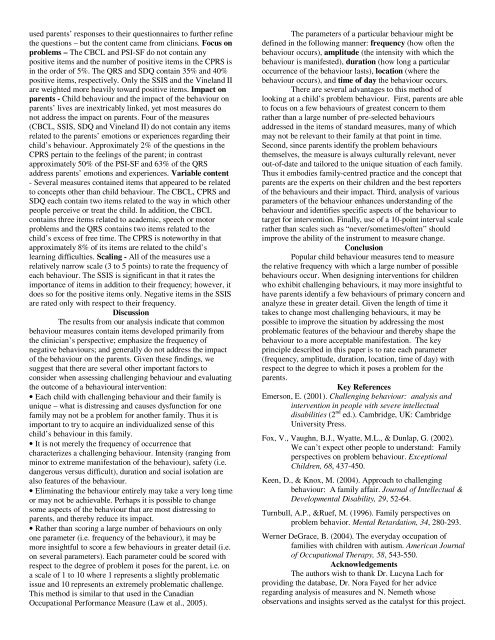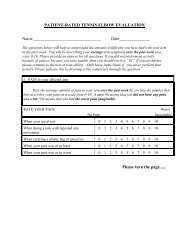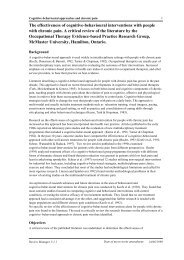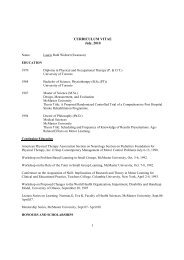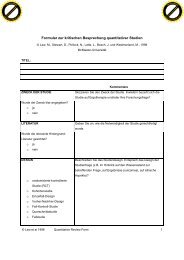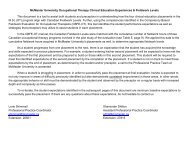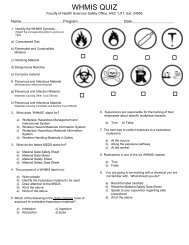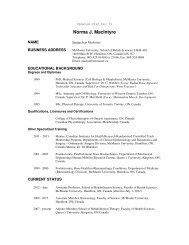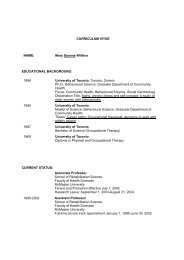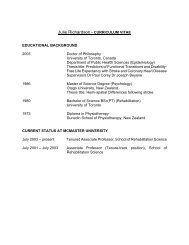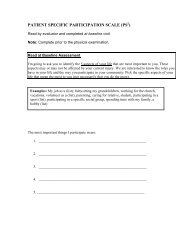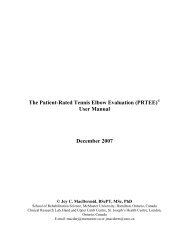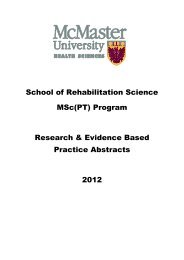Evidence Based Practice Symposium - McMaster University
Evidence Based Practice Symposium - McMaster University
Evidence Based Practice Symposium - McMaster University
You also want an ePaper? Increase the reach of your titles
YUMPU automatically turns print PDFs into web optimized ePapers that Google loves.
used parents’ responses to their questionnaires to further refine<br />
the questions – but the content came from clinicians. Focus on<br />
problems – The CBCL and PSI-SF do not contain any<br />
positive items and the number of positive items in the CPRS is<br />
in the order of 5%. The QRS and SDQ contain 35% and 40%<br />
positive items, respectively. Only the SSIS and the Vineland II<br />
are weighted more heavily toward positive items. Impact on<br />
parents - Child behaviour and the impact of the behaviour on<br />
parents’ lives are inextricably linked, yet most measures do<br />
not address the impact on parents. Four of the measures<br />
(CBCL, SSIS, SDQ and Vineland II) do not contain any items<br />
related to the parents’ emotions or experiences regarding their<br />
child’s behaviour. Approximately 2% of the questions in the<br />
CPRS pertain to the feelings of the parent; in contrast<br />
approximately 50% of the PSI-SF and 63% of the QRS<br />
address parents’ emotions and experiences. Variable content<br />
- Several measures contained items that appeared to be related<br />
to concepts other than child behaviour. The CBCL, CPRS and<br />
SDQ each contain two items related to the way in which other<br />
people perceive or treat the child. In addition, the CBCL<br />
contains three items related to academic, speech or motor<br />
problems and the QRS contains two items related to the<br />
child’s excess of free time. The CPRS is noteworthy in that<br />
approximately 8% of its items are related to the child’s<br />
learning difficulties. Scaling - All of the measures use a<br />
relatively narrow scale (3 to 5 points) to rate the frequency of<br />
each behaviour. The SSIS is significant in that it rates the<br />
importance of items in addition to their frequency; however, it<br />
does so for the positive items only. Negative items in the SSIS<br />
are rated only with respect to their frequency.<br />
Discussion<br />
The results from our analysis indicate that common<br />
behaviour measures contain items developed primarily from<br />
the clinician’s perspective; emphasize the frequency of<br />
negative behaviours; and generally do not address the impact<br />
of the behaviour on the parents. Given these findings, we<br />
suggest that there are several other important factors to<br />
consider when assessing challenging behaviour and evaluating<br />
the outcome of a behavioural intervention:<br />
• Each child with challenging behaviour and their family is<br />
unique – what is distressing and causes dysfunction for one<br />
family may not be a problem for another family. Thus it is<br />
important to try to acquire an individualized sense of this<br />
child’s behaviour in this family.<br />
• It is not merely the frequency of occurrence that<br />
characterizes a challenging behaviour. Intensity (ranging from<br />
minor to extreme manifestation of the behaviour), safety (i.e.<br />
dangerous versus difficult), duration and social isolation are<br />
also features of the behaviour.<br />
• Eliminating the behaviour entirely may take a very long time<br />
or may not be achievable. Perhaps it is possible to change<br />
some aspects of the behaviour that are most distressing to<br />
parents, and thereby reduce its impact.<br />
• Rather than scoring a large number of behaviours on only<br />
one parameter (i.e. frequency of the behaviour), it may be<br />
more insightful to score a few behaviours in greater detail (i.e.<br />
on several parameters). Each parameter could be scored with<br />
respect to the degree of problem it poses for the parent, i.e. on<br />
a scale of 1 to 10 where 1 represents a slightly problematic<br />
issue and 10 represents an extremely problematic challenge.<br />
This method is similar to that used in the Canadian<br />
Occupational Performance Measure (Law et al., 2005).<br />
The parameters of a particular behaviour might be<br />
defined in the following manner: frequency (how often the<br />
behaviour occurs), amplitude (the intensity with which the<br />
behaviour is manifested), duration (how long a particular<br />
occurrence of the behaviour lasts), location (where the<br />
behaviour occurs), and time of day the behaviour occurs.<br />
There are several advantages to this method of<br />
looking at a child’s problem behaviour. First, parents are able<br />
to focus on a few behaviours of greatest concern to them<br />
rather than a large number of pre-selected behaviours<br />
addressed in the items of standard measures, many of which<br />
may not be relevant to their family at that point in time.<br />
Second, since parents identify the problem behaviours<br />
themselves, the measure is always culturally relevant, never<br />
out-of-date and tailored to the unique situation of each family.<br />
Thus it embodies family-centred practice and the concept that<br />
parents are the experts on their children and the best reporters<br />
of the behaviours and their impact. Third, analysis of various<br />
parameters of the behaviour enhances understanding of the<br />
behaviour and identifies specific aspects of the behaviour to<br />
target for intervention. Finally, use of a 10-point interval scale<br />
rather than scales such as “never/sometimes/often” should<br />
improve the ability of the instrument to measure change.<br />
Conclusion<br />
Popular child behaviour measures tend to measure<br />
the relative frequency with which a large number of possible<br />
behaviours occur. When designing interventions for children<br />
who exhibit challenging behaviours, it may more insightful to<br />
have parents identify a few behaviours of primary concern and<br />
analyze these in greater detail. Given the length of time it<br />
takes to change most challenging behaviours, it may be<br />
possible to improve the situation by addressing the most<br />
problematic features of the behaviour and thereby shape the<br />
behaviour to a more acceptable manifestation. The key<br />
principle described in this paper is to rate each parameter<br />
(frequency, amplitude, duration, location, time of day) with<br />
respect to the degree to which it poses a problem for the<br />
parents.<br />
Key References<br />
Emerson, E. (2001). Challenging behaviour: analysis and<br />
intervention in people with severe intellectual<br />
disabilities (2 nd ed.). Cambridge, UK: Cambridge<br />
<strong>University</strong> Press.<br />
Fox, V., Vaughn, B.J., Wyatte, M.L., & Dunlap, G. (2002).<br />
We can’t expect other people to understand: Family<br />
perspectives on problem behaviour. Exceptional<br />
Children, 68, 437-450.<br />
Keen, D., & Knox, M. (2004). Approach to challenging<br />
behaviour: A family affair. Journal of Intellectual &<br />
Developmental Disability, 29, 52-64.<br />
Turnbull, A.P., &Ruef, M. (1996). Family perspectives on<br />
problem behavior. Mental Retardation, 34, 280-293.<br />
Werner DeGrace, B. (2004). The everyday occupation of<br />
families with children with autism. American Journal<br />
of Occupational Therapy, 58, 543-550.<br />
Acknowledgements<br />
The authors wish to thank Dr. Lucyna Lach for<br />
providing the database, Dr. Nora Fayed for her advice<br />
regarding analysis of measures and N. Nemeth whose<br />
observations and insights served as the catalyst for this project.


